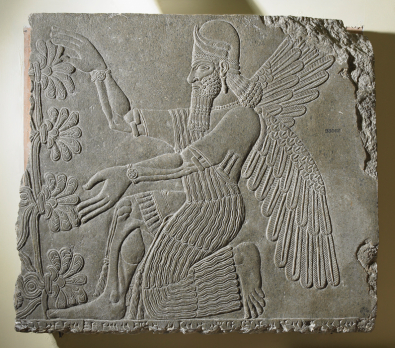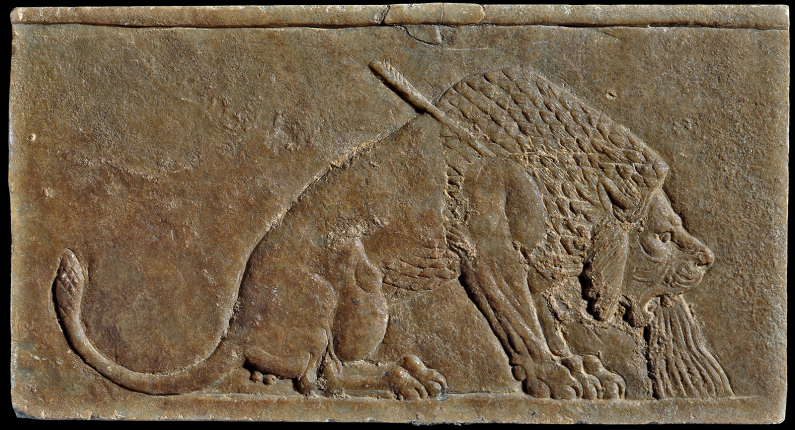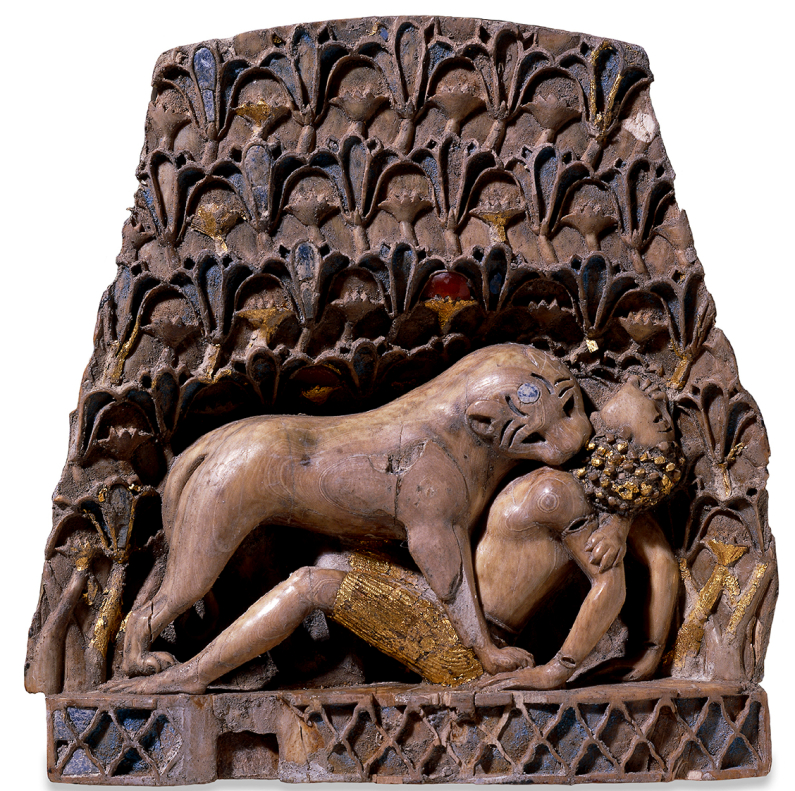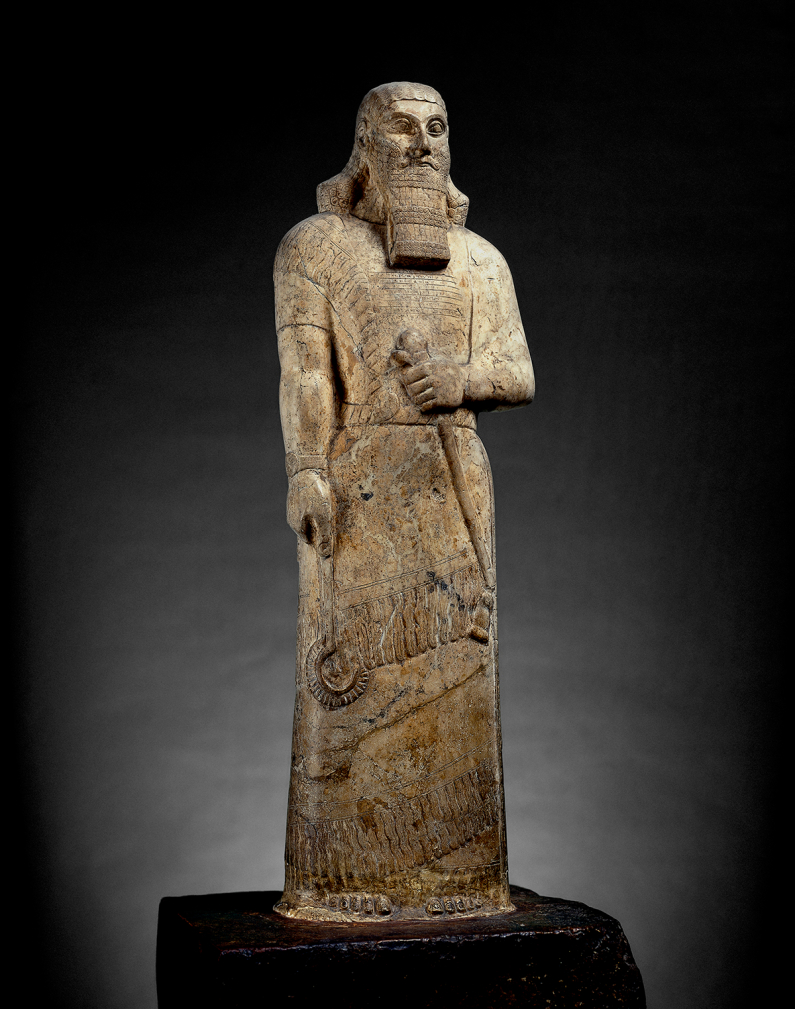

 BOSTON -- Ashurnasirpal II, Assyria's self-proclaimed "great king, mighty king, king of the universe," invited 70,000 guests to a 10-day housewarming party in 860 BC to show off his impressive new home at Kalhu. Constructed on 900 acres in northern Assyria--now modern-day Iraq--it was the most magnificent palace the ancient Near East had ever seen. Almost Boston (MFA), will also marvel at the wondrous decorations that West Palace when the exhibition, Art and Empire: Treasures from Assyria in the British Museum, goes on view in the Gund Gallery at the MFA from September 21, 2008--January 4, 2009. This exhibition showcases 250 objects from the British Museum, which has the finest collection of Assyrian art outside of Iraq, found in palaces and temples dating from the 9--7th centuries BC located at Kalhu (present-day Nimrud) and Nineveh along the Tigris River in northern Iraq. Art and Empire is collaboration between the British Museum and the Museum of Fine Arts, Boston.
BOSTON -- Ashurnasirpal II, Assyria's self-proclaimed "great king, mighty king, king of the universe," invited 70,000 guests to a 10-day housewarming party in 860 BC to show off his impressive new home at Kalhu. Constructed on 900 acres in northern Assyria--now modern-day Iraq--it was the most magnificent palace the ancient Near East had ever seen. Almost Boston (MFA), will also marvel at the wondrous decorations that West Palace when the exhibition, Art and Empire: Treasures from Assyria in the British Museum, goes on view in the Gund Gallery at the MFA from September 21, 2008--January 4, 2009. This exhibition showcases 250 objects from the British Museum, which has the finest collection of Assyrian art outside of Iraq, found in palaces and temples dating from the 9--7th centuries BC located at Kalhu (present-day Nimrud) and Nineveh along the Tigris River in northern Iraq. Art and Empire is collaboration between the British Museum and the Museum of Fine Arts, Boston.
The Neo-Assyrian empire -- which emcompassed much of today's Middle East -- represents a fascinating period, and this exhibition highlights the grand palaces, monumental wall reliefs, and rare artifacts of its kings," said Malcolm Rogers, Ann and Graham Gund Director of the MFA. "This spectacular collection also gives visitors the opportunity to explore the power, majesty, and sophistication of an ancient civilization that was little understood until it was rediscovered by archeologists less than two centuries ago."
Art and Empire chronicles Assyria's rise from a small landlocked kingdom in northern Mesopotamia to a magnificent empire stretching from the Persian Gulf to the Mediterranean Sea. Its territories encompassed all of present-day Iraq, Syria, and Lebanon, as well as large parts of Israel, Egypt, Turkey, and Iran--the greatest dominion known until that time. The exhibition features artistry created for several great Neo-Assyrian kings, from the first, Ashurnasirpal II (883--859 BC) of Nimrud, to the last, Ashurbanipal (668--631 BC), of Nineveh. Art and Empire brings the grandeur of this ancient Near Eastern realm to life through the display of 30 monumental wall reliefs, as well as numerous cuneiform clay tablets, sculpture--both statues and stelae--and cylinder seals. Works on view range from The king on campaign (about 875--860 BC), a regal wall relief of Ashurnasirpal II going to battle in Kurdistan, to Dying Lion (around 645 BC), the moving image of the noble beast in the throes of a painful death from an arrow lodged in his back, created during the reign of Ashurbanipal. (Among the finest wall relief carvings from this period are those of the lion hunts created for Ashurbanipal's North Palace at Nineveh.) These are among the many objects that shed light on the administration of the empire, culture, trade, personal beliefs, and interrelationships between religion, magic, and medicine. Military dress, equipment, and horse trappings illustrating army life, as well as decorative ivory pieces, furniture fittings, and metal vessels showcasing the luxurious cosmopolitan lifestyle enjoyed by royalty, are among the highlights of the exhibition.
"The reliefs from Nineveh and Nimrud are a visual encyclopedia of ancient Mesopotamia, one of the cradles of civilization," said exhibition curator Lawrence Berman (the MFA's Norma Jean Calderwood Senior Curator of Ancient Egyptian, Nubian, and Near Eastern Art). "Today we are particularly aware how vulnerable these archaeological sites are in Iraq, and we can appreciate better than ever the efforts of archaeologists and museums past and present to preserve this part of the world's heritage."
In the mid 19th century, the full scope of ancient Assyria's grandeur and supremacy was revealed through the efforts of French and British explorers. Preeminent among them was Austen Henry Layard, a British archeologist, whose interest was piqued by a large mound near Mosul, which he thought was ancient Nineveh. It proved to be Nimrud, the site of the ancient Assyrian city of Kalhu (known as Calhu in the Bible), and his discoveries there and at Nineveh in the 1840s and '50s form the core of Art and Empire. Later excavations in the region by such notables as Hormuzd Rassam, George Smith, and Sir Max Mallowan, including finds made at Ashur and Khorsabad, complete the picture of Assyrians as mighty warriors and cultured sophisticates whose deeds were recorded in stone.

The richness of Assyrian culture is the focus of Art and Empire, which is organized to highlight such subjects as the king and his world of opulence; the palaces and temples of the kingdom; the importance of warfare; royal lion and bull hunts; the significance of magic and religion; the royal fascination with literature and science, and administration and society.
The interiors of Ashurnasirpal II's palace at Nimrud, as well as Sennacherib's palace at Nineveh, were magnificently adorned using wall reliefs as paneling along the bottom half of painted, mud-brick walls. Figuring prominently in the exhibition, these gypsum slabs are artfully carved with iron and copper tools. They average in size from about three-feet square, such as Three Protective Spirits (about 645--640 BC), to the immense and panoramic, such as The Battle of Til-Tuba (about 650 BC)--consisting of three panels, each roughly 6 feet square. (All are technically fragments, having been cut down from larger compositions and even entire walls.) They shed light not only on techniques of warfare, but also on daily activities, religion, and the luxurious lifestyle enjoyed by Assyrian kings. Brightly colored (faint traces of the original paint are sometimes evident) so that they could be seen in the palace's dimly lit staterooms and living quarters, the wall reliefs feature the kings as fierce warriors, hunters, and worshipers of Assyrian gods. Cuneiform inscriptions herald their conquests and achievements. Fantastic mythical creatures as well as protective winged genii ward away evil spirits. Such expansive wall reliefs were part of an elaborate decorative plan that glorified the king; they also served as propaganda--proclaiming his awesome majesty while warning of the gruesome death and destruction that would befall his enemies.
In addition to mandating a new look for Assyrian palaces, Ashurnasirpal II was responsible for the creation of Assyrian sculpture as we now know it. Carved in magnesite, an extremely hard stone, the Statue of Ashurnashirpal II (883--859 BC), stands approximately 6 feet tall with its original pedestal, and is the largest and best preserved Assyrian royal sculpture in the round. The ruler appears without a crown, but with long hair and an ornately curled beard. He wears a tunic and fringed shawl, and carries a ceremonial sickle to fight monsters, as well as a mace symbolizing his god-given authority. Inscribed on his chest is a list of his titles and ancestors. The statue was found in the Temple of Ishtar, where it was placed as a devotional piece.
Sculpture, in the form of monumental bas-reliefs, chronicled a king's achievements, particularly on the battlefield, where wars were conducted in the name of the state god, Ashur, from whom the name "Assyria" is derived. Escape across a river (about 875--860 BC) dramatizes an incident during the reign of Ashurnasirpal II when, in 878 BC, the king and his soldiers encountered enemies near the Euphrates river. Assyrian archers along the river bank are seen in the relief shooting at the men, who are swimming away to safety with the aid of inflated animal skins. Another work, The Battle of Til-Tuba, dates to the reign of Ashurbanipal. Its depiction of bloody warfare reinforces the Assyrians' reputation for ruthlessness. The Battle of Til-Tuba, a monumental work considered the finest large-scale composition in Assyrian art, shows the Assyrians defeating the Elamites of southern Iran. Scenes highlight the Elamite king's chariot crashing down, the king's flight from the wreckage, and his capture and beheading, with the severed head being carried back as a trophy to Assyria. The story unfolds amid a backdrop of horrible carnage and the confusion of battle.
Overseeing human interactions are the protective spirits and demons associated with Assyrian magic and religion, who guarded the palace against harmful influences. Set of protective spirits (about 645--640 BC), from Ashurbanipal's North Palace in Nineveh, features three magical figures who protected the king as a set: a lahmu, or Mesopotamian diety; an ugallu or "Great Lion;" and what appears to be a House God. Their features conform to precise rules of design and they are shown as though viewed from the front, while their heads are in profile--a standard Assyrian convention for representations of the human body. Clay tablets and amulets inscribed with incantations also were used to deter demonic spirits. Included in Art and Empire are several of these tablets, which also feature magical spells. Amulets, inscribed with incantations, were worn as protective devices. Stone head of Pazuzu and Bronze head of Pazuzu, both from the 8th--7th century, show the mythical evil creature, known as the "scary demon," whose image could be used for good, especially in the instance of protecting expectant mothers and newborns.
Large wall reliefs also were used to document the kings' preoccupation with hunting. Lion hunts provided an outlet for non-wartime combat, as Assyrians saw lions as savage enemies representing untamed nature. Royal lion hunt (about 875--860 BC) shows the king with bow drawn, ready to shoot once more at a fallen lion about to be trampled upon by the king's horses. At one point in Assyrian history, it was decreed that only royalty could kill lions.
Such rules and regulations, as well as public documents (tax rolls, agricultural records, treaties), religious rituals, and literary texts were written in cuneiform script and preserved on clay tablets, many of which were discovered by Layard's protégé, Hormuzd Rassam, from the extensive library at Ashurbanipal's palace in Nineveh. The king asserted that he could read the wedge-shaped cuneiform script, and his desire to preserve in one place all of the world's important works of literature and science has been called visionary. Some of the works collected by Ashurbanipal were 1,000 years old at the time. Included in the king's library were fragments from a copy of the Epic of Creation (7th century BC) as well as from The Epic of Gilgamesh (7th century BC), considered the most important work of Mesopotamian literature. In the 19th and 20th century, more than 20,000 cuneiform tablets were discovered by the British Museum.
While stone wall reliefs served as the primary aesthetic enhancement in Assyrian palaces and temples of the 9th --7th century, other objects in Art and Empire highlight the refinement of their decorative arts. Intricately carved ivory pieces often were used to embellish royal furnishings, sometimes accented with semi-precious stones and gold leaf, such as in The Lioness and the African (9th--8th century BC). The panel, which depicts a lion mauling a man in front of a beautifully carved floral background, is most likely Phoenician, acquired through trade or as war booty(The only other plaque of this kind, one of the treasures of the Iraq Museum in Baghdad, has been missing since 2003.) Another ivory panel is Woman at the window (9th --8th century BC), which captures the contemplative expression of a woman in Egyptian headdress staring out the window. Intricate carvings also can be found on cylinder seals used by the royal household; when rolled out over clay, the impressions they made served as official seals. Often crafted from semi-precious stone, the cylinders featured scenes of kings, warriors, gods, as well as animals in combat. Such cylinders were used to form a parure, or jewelry set, commissioned by Layard as a wedding gift for his wife, Enid. After wearing her grand necklace of Assyrian, Akkadian, Babylonian and Achaemenidian cylinders and seals, Lady Layard later wrote in her diary that it was "much admired" by Queen Victoria when the Layards dined with her in 1873.
Other decorative items found during excavations by Layard include intricately incised bronze bowls and plates. In 1849, he discovered at the Nimrud site the so-called "Room of the Bronzes" containing hundreds of objects, about 150 of which were sent to the British Museum. Called the Nimrud Bowls, they were most likely acquired as war booty or royal tribute. Bronze also was used to decorate wooden doors erected by Shalmaneser III (858--824 BC) at his palace at Balawat. Sixteen embossed and chased bands from the Balawat Gates, approximately 10 inches tall by 70 inches wide, were discovered, documenting in exacting detail various incidents from the king's campaign in 859 BC. Two bands are included in the exhibition as are such objects as portraits of Lord Austen and Lady Enid Layard, a copy of Layard's 1854 book, The Monuments of Nineveh, and photographs and descriptions of Assyrian excavations.
Admission/Hours
Admission to Art and Empire: Treasures from Assyria in the British Museum, which includes general admission and a return visit to the MFA's collection within 10 days, is by ticket only for a reserved date and time of entry at half-hour intervals. Although same-day tickets will be sold (when available) at the Museum's box office, advance reservations are recommended to ensure admission to the exhibition. Tickets can be purchased by visiting the MFA's Box Office, the website www.mfa.org, or by calling 800.440.6975.
The Museum of Fine Arts, Boston



or register to post a comment.